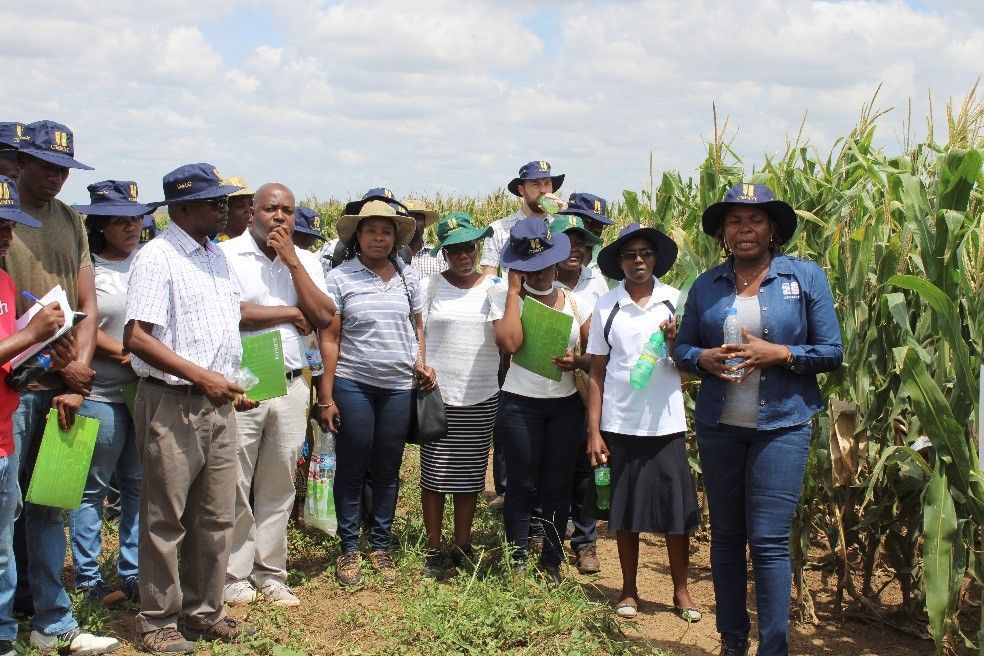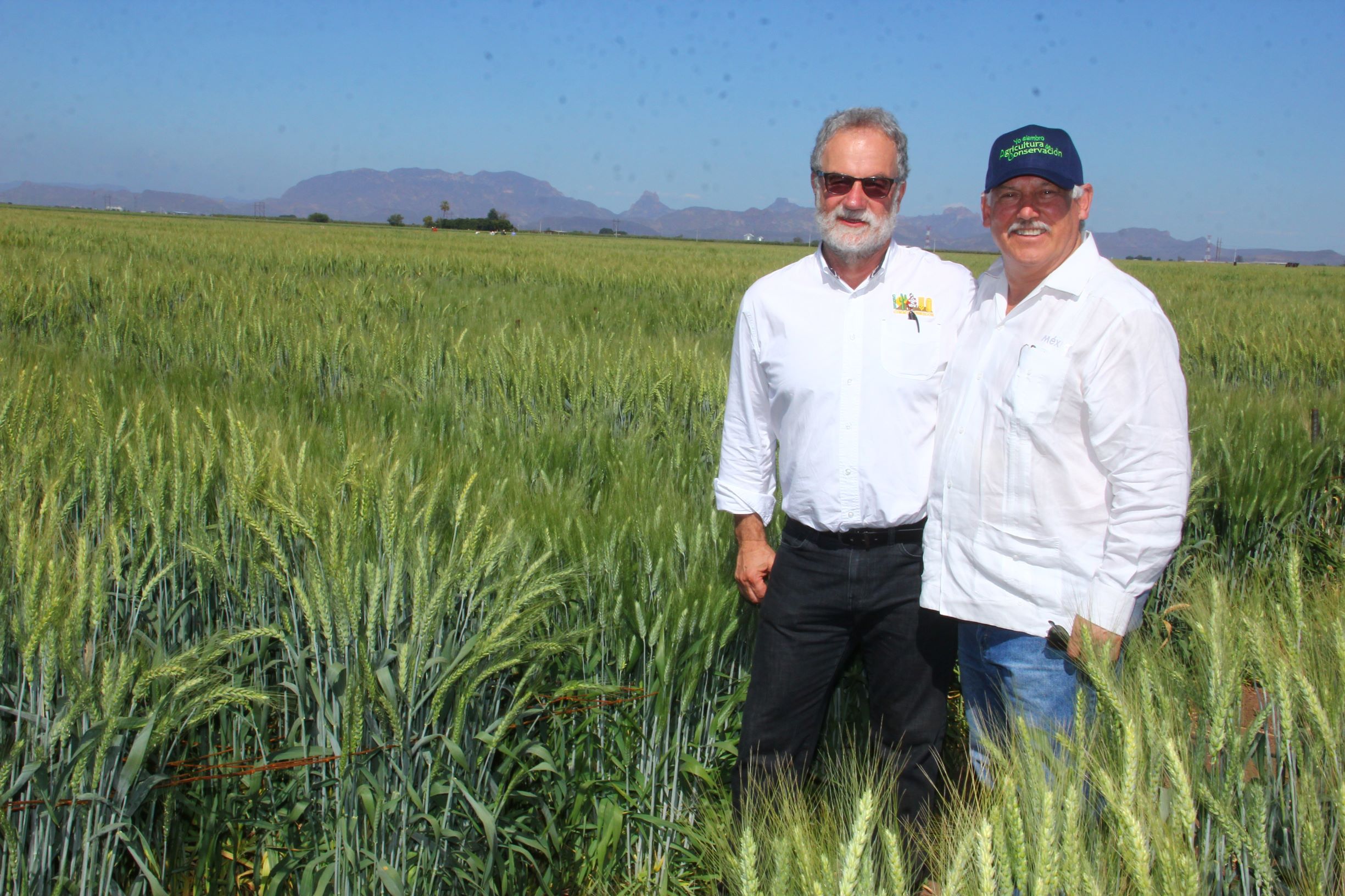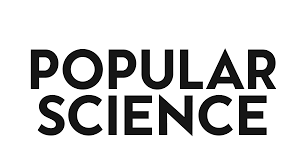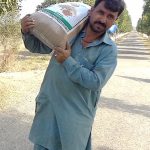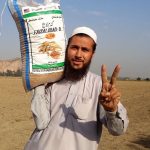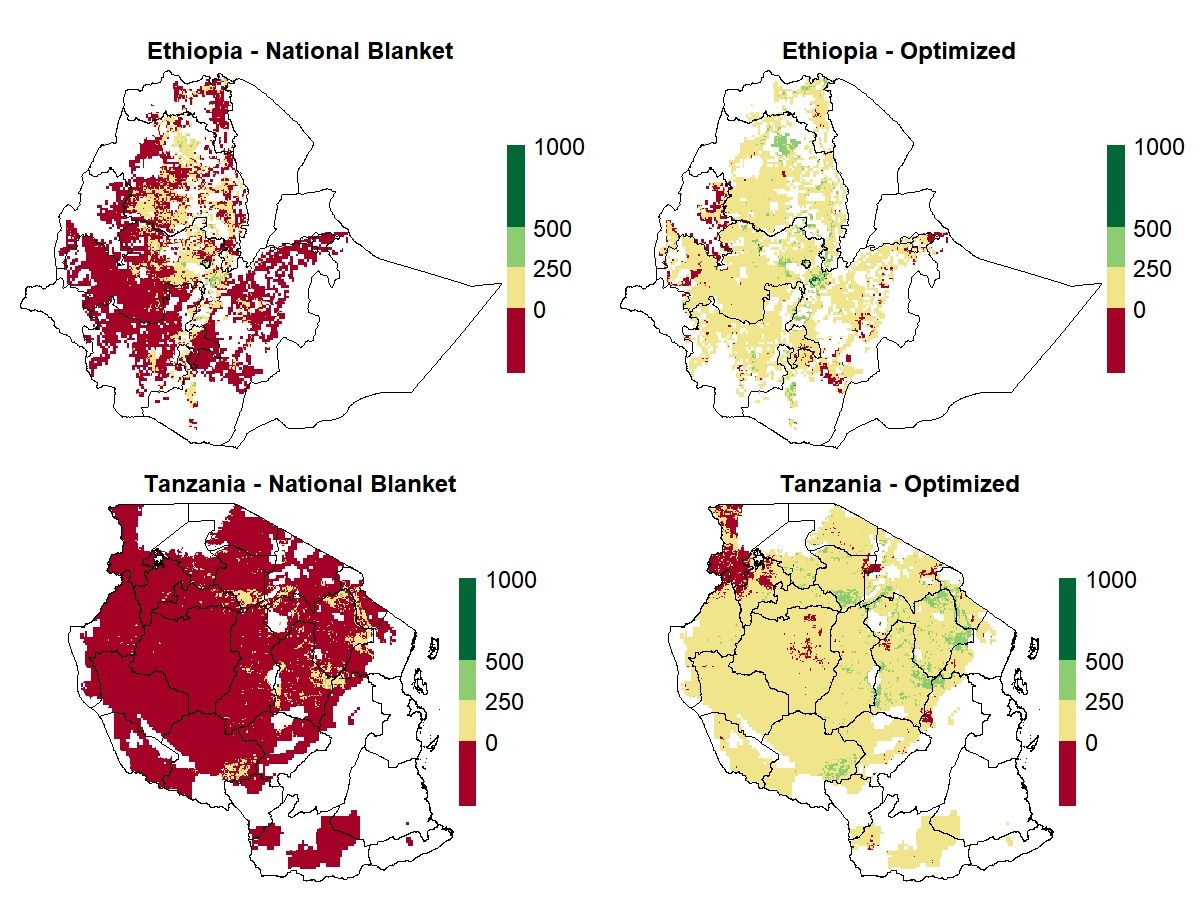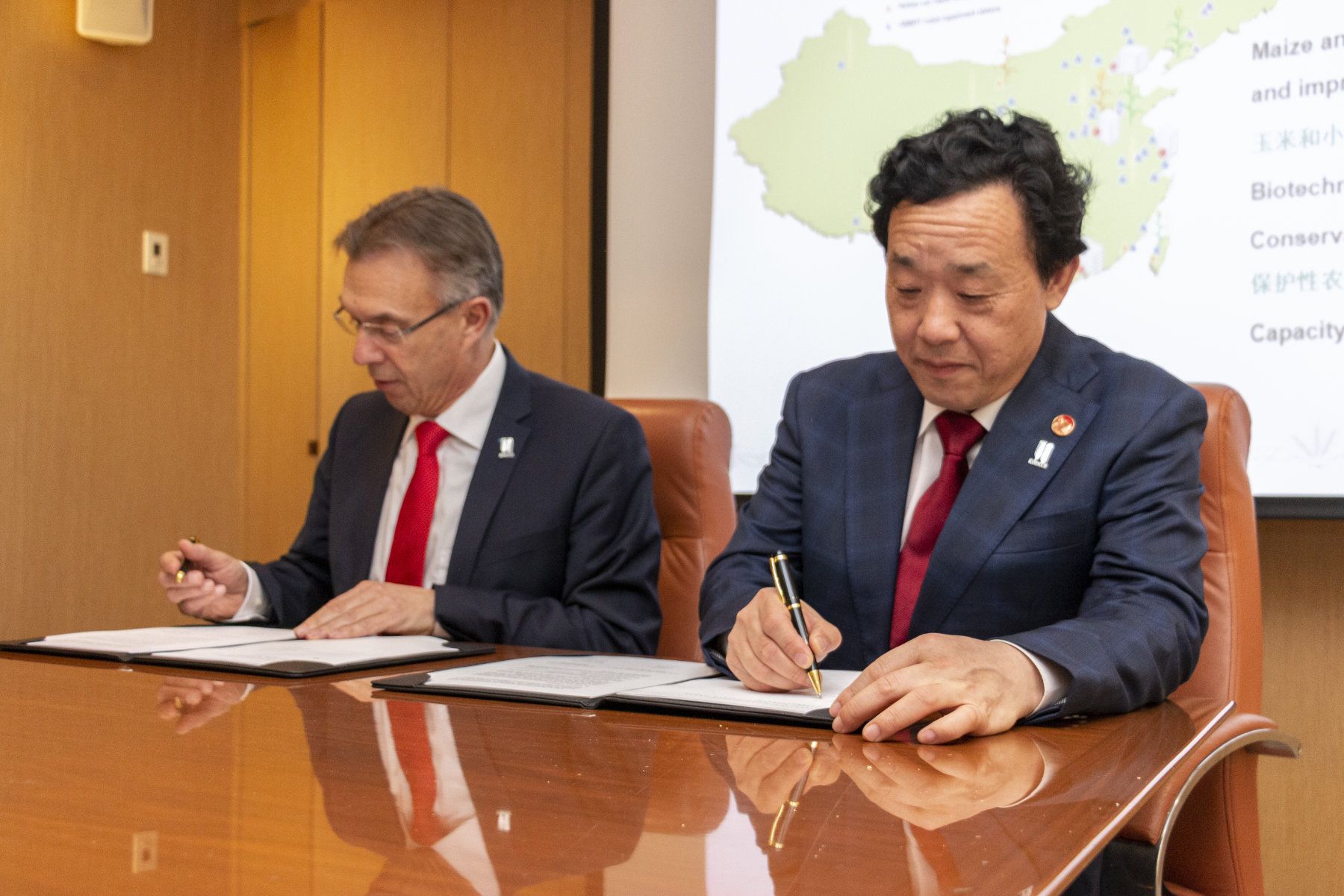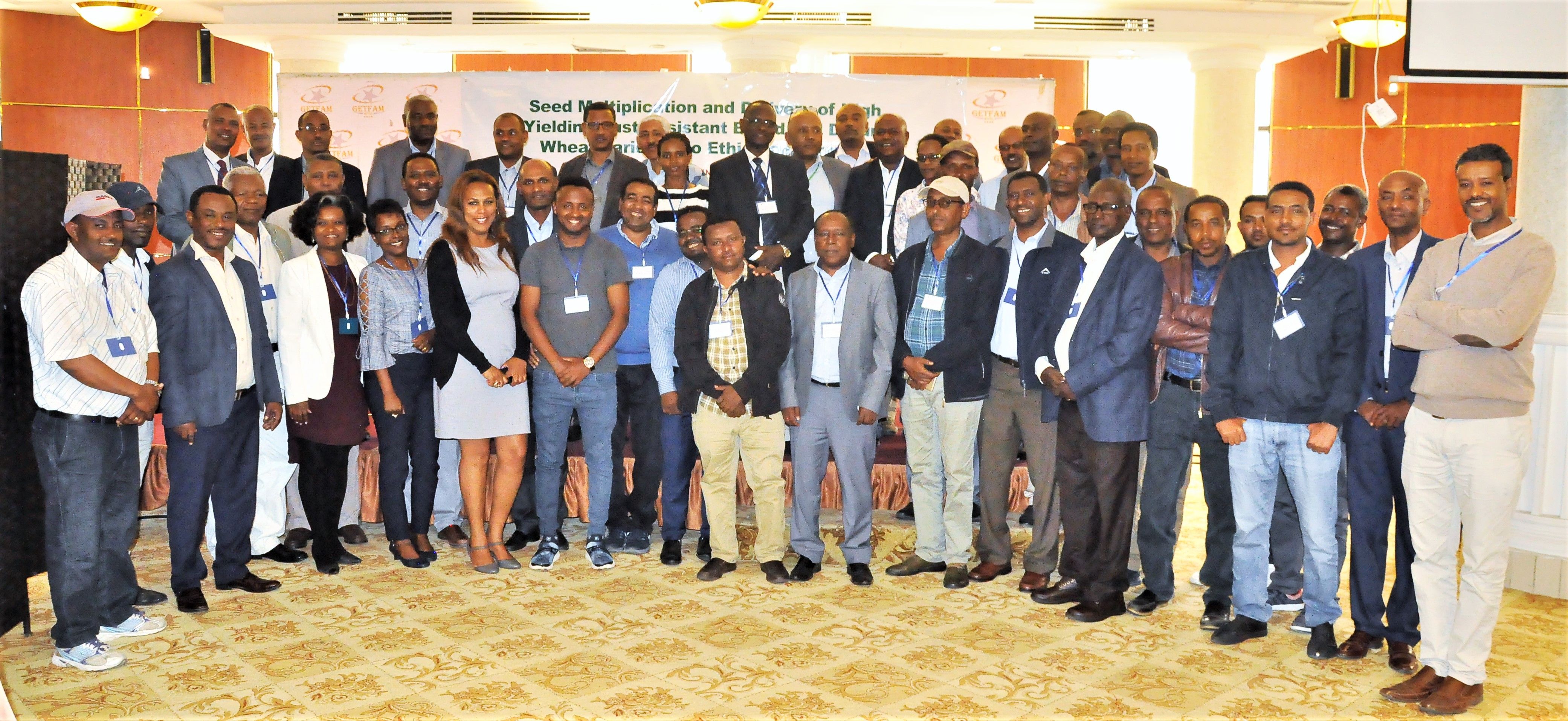What’s new in southern Africa?
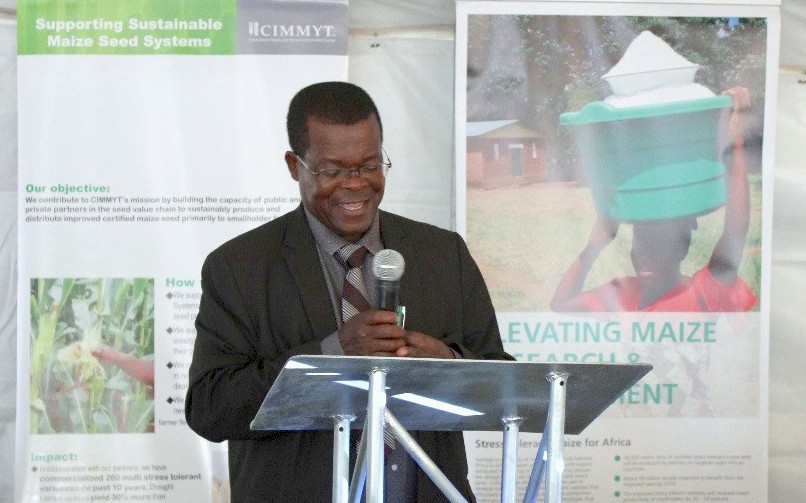
On March 14, 2019, over 200 of the International Maize and Wheat Improvement Center’s (CIMMYT) partners in southern Africa, including national research organisations, private seed companies and funders, attended the annual partners field day in Harare, Zimbabwe.
“For the last 34 years, CIMMYT’s regional office has expanded its research work, from maize breeding to sustainable cropping practices and recently appropriate mechanization and post-harvest,’’ said Cames Mguni, Director of Zimbabwe’s Department of Research and Specialist Services. “The development of drought and heat tolerant maize varieties helps farmers get better yields and cope better during drought years such as the current 2018/19 season.”
Elijah Nyabadza, Dean of the University of Zimbabwe’s Faculty of Agriculture, highlighted the strong collaboration between the University and CIMMYT in conducting joint research and building cutting-edge skills of the next generation of agricultural scientists and practitioners in the region.
Welthungerhilfe country director Regina Feindt said the partner field day was ‘’a very valuable experience and a great opportunity to gain technical know-how and exchange with colleagues across the region.’’
CIMMYT showcases research impact
At the event, CIMMYT country representative for Zimbabwe Cosmos Magorokosho walked partners through breeding lines that include special lines testing for resistance to diseases such as fall armyworm, maize streak virus and weevil. Maize breeder Amsal Tarekegne explained how, in product development, various inbred lines are combined to create new hybrids. These new hybrids, added seed systems specialist Peter Setimela, are made available to smallholder farmers for performance testing for stress tolerance and nutritional traits under different environments before being released to seed companies for multiplication.
Two Zimbabwean seed companies present at the field day highlighted the benefits of collaboration with CIMMYT. Chrispen Nyamuda, an agronomist from Zadzamatura seed company, explained that many varieties popular with farmers, which are heat-tolerant and resistant to diseases like maize streak virus and grey leaf spot disease, were developed thanks to their collaboration with CIMMYT. Another partner from Mukushi Seeds described the working partnership with CIMMYT as mutually beneficial. “We exchange lines, plant in different environments and share the results,” he explained. “We are also tapping germplasm from the world through CIMMYT’s global reach.”
Mainassara Zaman-Allah and Jill Cairns, CIMMYT’s high throughput phenotyping experts, elaborated on how cost-effective remote sensing technologies significantly reduce costs for screening for specific traits and assessing the potential extent of damage caused by pests such as fall armyworm.
Over the last couple of years, CIMMYT has intensified maize breeding efforts aimed at improving the nutritional value of maize, particularly higher content in provitamin A and better quality protein. Maize breeder Thokozile Ndhlela explained that more than 15 new hybrids with higher levels of provitamin A have been released in southern Africa, including five in Zimbabwe.
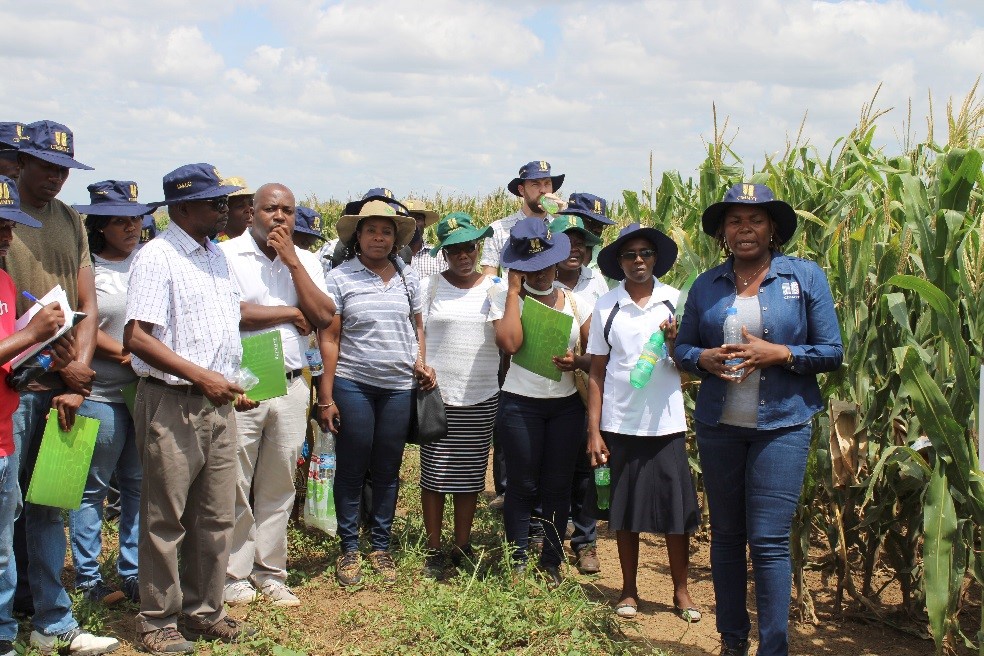
Agronomists Christian Thierfelder and Isaiah Nyagumbo shared some conservation agriculture techniques adopted by smallholder farmers. Farmers can realize better yields and improve their climate resilience by combining conservation agriculture principles such as minimum soil disturbance, crop rotation and soil cover, with use of stress tolerant maize varieties, appropriate mechanization and other complementary practices. Frederic Baudron, who leads the Farm Mechanization and Conservation Agriculture for Sustainable Intensification (FACASI) initiative, explained how small mechanization like two-wheel planters could address labour shortages, reduce drudgery and generate opportunities for rural youth. Significant drudgery reductions have already been observed in wheat planting in Rwanda, and in post-harvest operations like shelling and threshing in Ethiopia and Zimbabwe.
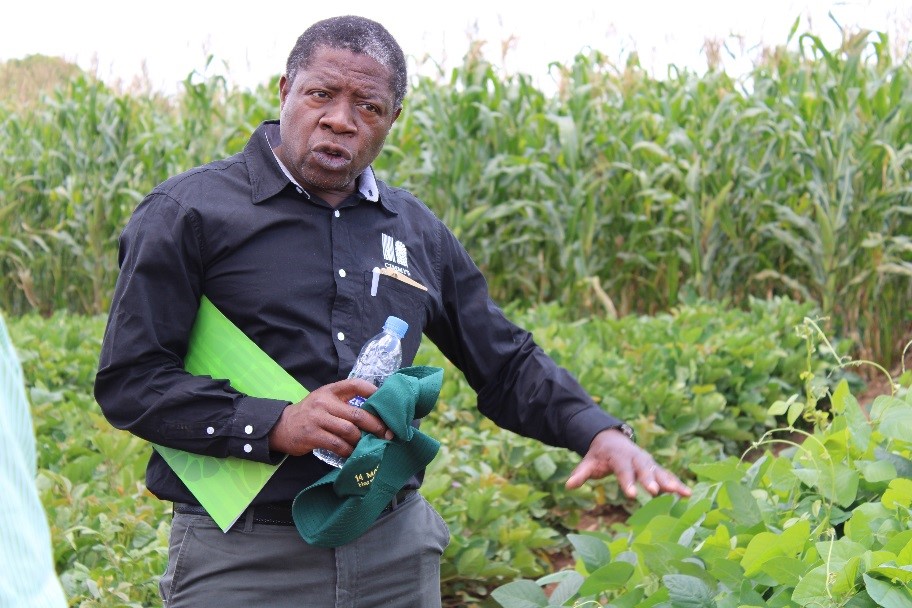
The International Maize Improvement Consortium one year on
Following the annual partners field day, members of the International Maize Improvement Consortium (IMIC) held a field day to select varieties from the IMIC Southern Africa demo plot, which carries a wider selection of materials. Launched in May 2018, IMIC is a public-private partnership initiative established as part of CIMMYT’s mission to increase seed breeding and production innovations.
Participating IMIC members came from seed companies based in Angola, Egypt, Ethiopia, Kenya, Nigeria, Tanzania, Uganda, Zambia and Zimbabwe. At the field day, they were advised by research associate Obert Randi on the layout of the demonstrations for materials under development for different traits, resilience to fall armyworm and maize streak virus, materials improved for vitamin A and quality protein and stress tolerant lines.
After going through the selections, participating IMIC members proceeded to the Quarantine Facility in Mazoe, where they explored around 2,300 double haploid lines undergoing screening maize lethal necrosis (MLN) as well as multiplication for distribution to non-MLN prevalent countries.
The final part of the field day provided space for the members to share research learnings and input on how to move the consortium forward. The field day concluded with an inaugural meeting of the steering committee chaired by CIMMYT regional representative for Africa Stephen Mugo, where participants discussed a number of issues including membership, procedures for conducting field days, training and research prioritization.
Both field days offered an opportunity to highlight the extended impact of CIMMYT’s research in southern Africa through strong partnerships and commitment to research on maize breeding, sustainable farming practices, mechanization and socio-economic impacts of all programming.
Breaking Ground: Tawanda Mashonganyika unites crop breeders and market experts for more impactful varieties
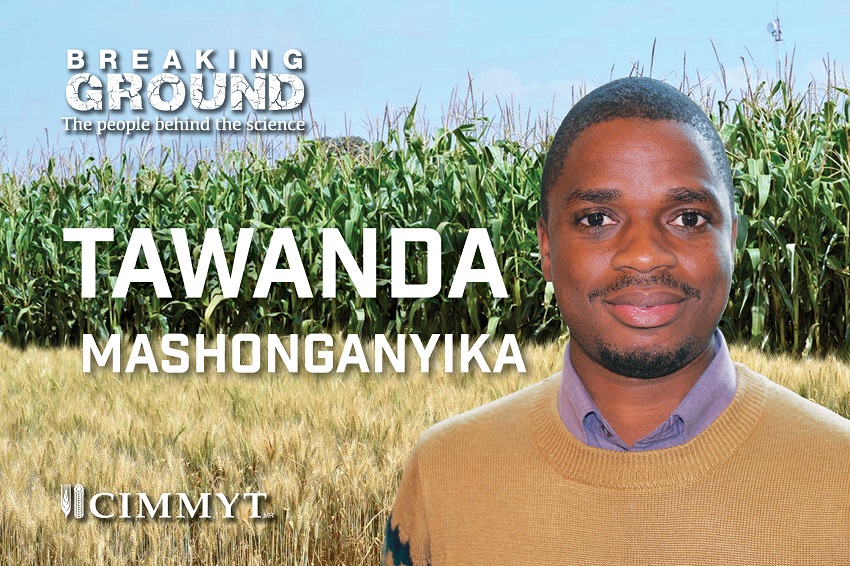
The low rate at which farmers adopt improved varieties is one of the biggest obstacles to overcoming food insecurity. The average maize variety grown by farmers in sub-Saharan Africa is 15 years old, even though maize breeders have been releasing more than 50 new varieties every year.
When it comes to climate change, for example, thanks to a plentiful arsenal of genetic diversity crop breeders are developing varieties adapted to increased heat and drought, but farmers continue to grow crops developed for the climate of yesterday.
One part of the answer is that it is not enough merely to create a variety resistant to heat, drought or flooding; complex dynamics are at play in crop markets and in farmers’ fields that must be reflected in the design of new varieties.
This where product manager Tawanda Mashonganyika comes in, working for the CGIAR Excellence in Breeding Platform (EiB) out of CIMMYT-Kenya, and one of the first to occupy such a role in the CGIAR system.
“This position is supposed to bring in a business kind of thinking in the way products and varieties are developed,” said Mashonganyika, who studied agricultural economics, agribusiness and value chains at the universities of Reading, U.K. and Queensland, Australia, and has professional experience with crops grown in Africa.
“You need to know who you are developing varieties for, who are your customers and clients, and you also need to design products so that they can have success on the market.”
Mashonganyika’s role is to support CGIAR and national agricultural research system (NARS) breeders to design new varieties focused on replacing older products in a specific market, as opposed to only breeding for an agro-ecological zone. Key to this approach is the involvement of experts from other disciplines such as gender, socioeconomics and nutrition, as well as people involved in the value chain itself, such as food processors, seed producers and farmers.
The outcome of this collaboration is a product profile: a written description of a new product with all the traits needed to replace the variety that currently dominates the target market. The profile serves as a common goal for CGIAR and NARS collaboration, and as a tool to communicate with donors. With the breeding program accountable for delivering a pipeline of new products designed for impact, they can ensure that these varieties also deliver traits such as biofortification to farmer’s fields.
Instead of breeding for all the traits that may be desirable in a new variety, what sets the product profile approach apart is that breeding programs can then focus resources on the traits that will have the greatest impact in the market, and therefore the field. This market-focused approach also enables better collaboration between breeders and experts from other disciplines:
“When you bring a cross-functional team together, you really need to give them an understanding of the desired goal of what we want to design and eventually put onto the market,” said Mashonganyika. “We put an emphasis on data-driven decisions, so it is not just a meeting of experts with different opinions; we always try to create a platform to say ‘we need to follow what the market is saying.’”
“[Non-breeding experts] are usually very excited to talk about the data that they have about markets, and the knowledge that they have about how gender or nutrition affects products on the market,” said Mashonganyika. “There are so many women farmers, especially in Africa, so when you begin to incorporate gender, we are increasing the scope of impact.”
Although actors such as seed producers or food processors may have no breeding expertise, Mashonganyika views their input as essential: “They are the ones that are at the mouthpiece of the market, they eventually take up the varieties and they multiply the seed, so they have very good information.”
One example is a collaboration with the National Agricultural Research Organization (NARO), Uganda, where representatives from private sector seed companies are being included to help breeders better understand their customers. “They give information about seed multiplication processes, and what makes a variety be considered for multiplication in seed systems.”
EiB has created a standardized tool to create product profiles, and 200 were submitted to the growing database in the first three months of the pilot period alone, including profiles submitted by 10 national agricultural research programs in Africa and Asia.
In addition to promoting the use of product profiles, a product manager is also involved ensuring communication and accountability throughout the development of new products.
“With product profiles we say a breeder should be accountable for delivering each product in a certain timeframe,” said Tawanda. “We always emphasize that a breeding program should have an annual product review process, because markets are dynamic, they are bound to change. This is a good habit to ensure that your products remain relevant and designed for impact.”
Although Mashonganyika is one of the first CGIAR product managers, a desire to see greater impact in the field is turning others in the same direction.
“I hope that in the near future we will see other CGIAR centers developing similar positions,” said Mashonganyika.
Mexican Secretary of Agriculture joins new partners and longtime collaborators in Obregon
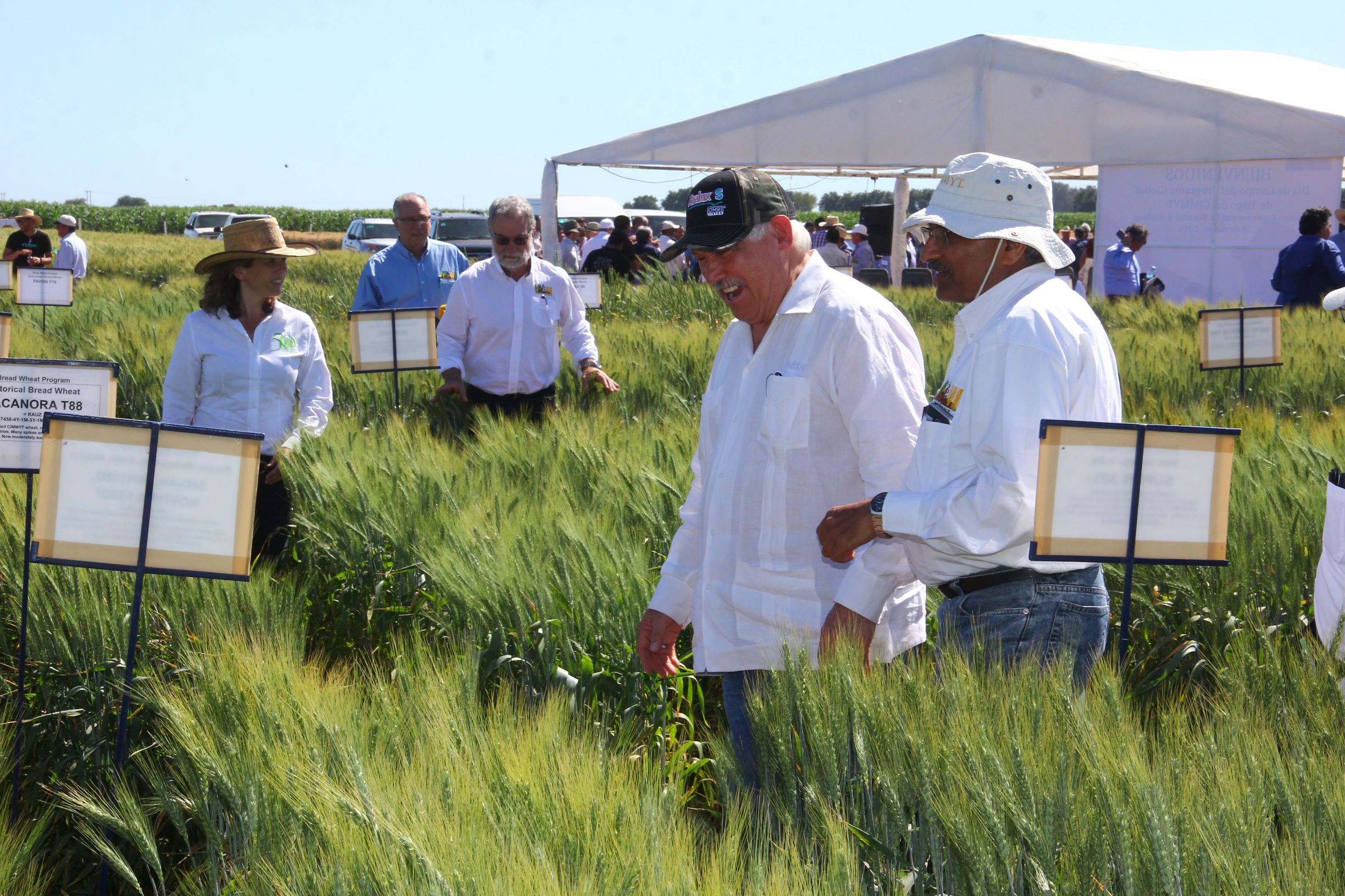
“The dream has become a reality.” These words by Victor Manuel Villalobos Arambula, Secretary of Agriculture and Rural Development of Mexico, summed up the sentiment felt among the attendees at the International Maize and Wheat Improvement Center (CIMMYT) Global Wheat Program Visitors’ Week in Ciudad Obregon, Sonora.
In support of the contributions to global and local agricultural programs, Villalobos spoke at the week’s field day, or “Dia de Campo,” in front of more than 200 CIMMYT staff and visitors hailing from more than 40 countries on March 20, 2019.
Villalobos recognized the immense work ahead in the realm of food security, but was optimistic that young scientists could carry on the legacy of Norman Borlaug by using the tools and lessons that he left behind. “It is important to multiply our efforts to be able to address and fulfill this tremendous demand on agriculture that we will face in the near future,” he stated.
The annual tour at the Campo Experimental Norman E. Borlaug allows the global wheat community to see new wheat varieties, learn about latest research findings, and hold meetings and discussions to collaborate on future research priorities.
Given the diversity of attendees and CIMMYT’s partnerships, it is no surprise that there were several high-level visits to the field day.
A high-level delegation from India, including Balwinder Singh Sidhu, commissioner of agriculture for the state of Punjab, AK Singh, deputy director general for agricultural extension at the Indian Council of Agricultural Research (ICAR), and AS Panwar, director of ICAR’s Indian Institute of Farming Systems Research, joined the tour and presentations. All are longtime CIMMYT collaborators on efforts to scale up and disseminate sustainable intensification and climate smart farming practices.
Panwar, who is working with CIMMYT and partners to develop typologies of Indian farming systems to more effectively promote climate smart practices, was particularly interested in the latest progress in biofortification.
“One of the main objectives of farming systems is to meet nutrition of the farming family. And these biofortified varieties can be integrated into farming systems,” he said.
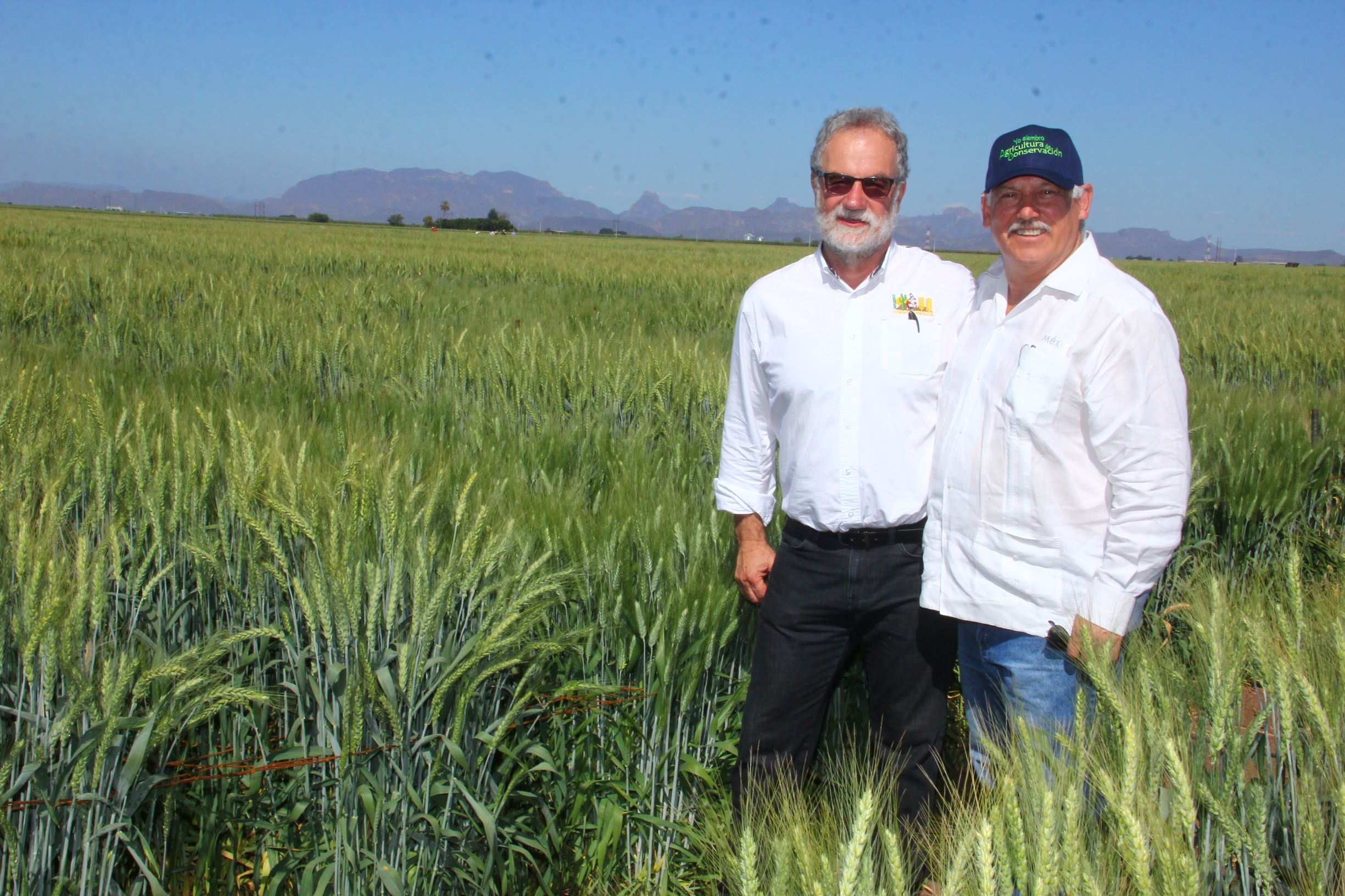
In addition, a delegation from Tunisia, including dignitaries from Tunisia’s National Institute of Field Crops (INGC), signed a memorandum of understanding with CIMMYT officials to promote cooperation in research and development through exchange visits, consultations and joint studies in areas of mutual interest such as the diversification of production systems. INGC, which conducts research and development, training and dissemination of innovation in field crops, is already a strong partner in the CGIAR Research Program on Wheat’s Precision Phenotyping Platform for Wheat Septoria leaf blight.
At the close of the field day, CIMMYT wheat scientist Carolina Rivera was honored as one of the six recipients of the annual Jeanie Borlaug Laube Women in Triticum (WIT) Early Career Award. The award offers professional development opportunities for women working in wheat. “Collectively, these scientists are emerging as leaders across the wheat community,” said Maricelis Acevedo, Associate Director for Science for Cornell University’s Delivering Genetic Gain in Wheat Project, who announced Rivera’s award.
CGIAR Research Program on Wheat and Global Wheat Program Director Hans Braun also took the opportunity to honor and thank three departing CIMMYT wheat scientists. Alexey Morgounov, Carlos Guzman and Mohammad Reza Jalal Kamali received Yaquis, or statues of a Yaqui Indian. The figure of the Yaqui Indian is a Sonoran symbol of beauty and the gifts of the natural world, and the highest recognition given by the Global Wheat Program.
The overarching thread that ran though the Visitor’s Week was that all were in attendance because of their desire to benefit the greater good through wheat science. As retired INIFAP director and Global Wheat Program Yaqui awardee Antonio Gándara said, recalling his parents’ guiding words, “Siempre, si puedes, hacer algo por los demas, porque es la mejor forma de hacer algo por ti. [Always, if you can, do something for others, because it’s the best way to do something for yourself].”

Cobs & Spikes podcast: Striving for higher quality, more nutritious maize
While increasing yields will be necessary to feed the 9.8 billion people expected by 2050, Natalia Palacios — head of the maize nutritional quality laboratory at CIMMYT — says that’s only part of the challenge. She argues we must also strive for higher-quality, more nutritious crops. According to the United Nations Food and Agriculture Organization, over 800 million people are considered undernourished. That’s about one out of every nine people in the world. Find out how Palacios’ research helps CIMMYT and its partners close the gap and support better health and nutrition.
For more information on Palacios’ research linking provitamin A orange maize and reduced aflatoxin contamination, read the publication here.
Fighting hidden hunger with agricultural innovation
Maize provides 15-16 percent of total calorie intake in Asia, Latin America and sub-Saharan Africa, while wheat provides 18 percent of our total available calories. Hidden hunger occurs when these calories don’t provide the essential micronutrients, such as iron, zinc and vitamin A, needed for healthy growth and prevention of diseases.
On World Health Day, we are sharing five stories showing how the International Maize and Wheat Improvement Center (CIMMYT) is combating hidden hunger and how agricultural research and innovation leads to healthier families, improved livelihoods and a healthier planet.
Climate change impact and adaptation for wheat protein
Often, work on climate change adaptation in agriculture focuses on productivity instead of nutrition of crops. If nutritional implications of climate change are not addressed, there will be devastating consequences on the health and livelihoods of marginalized people who depend on wheat as a source of protein.
A new study examines why wheat grain protein concentration is often overlooked in relation to improving global crop production in the face of climate change challenges and concludes that not all climate change adaptations have positive impacts on human nutrition.
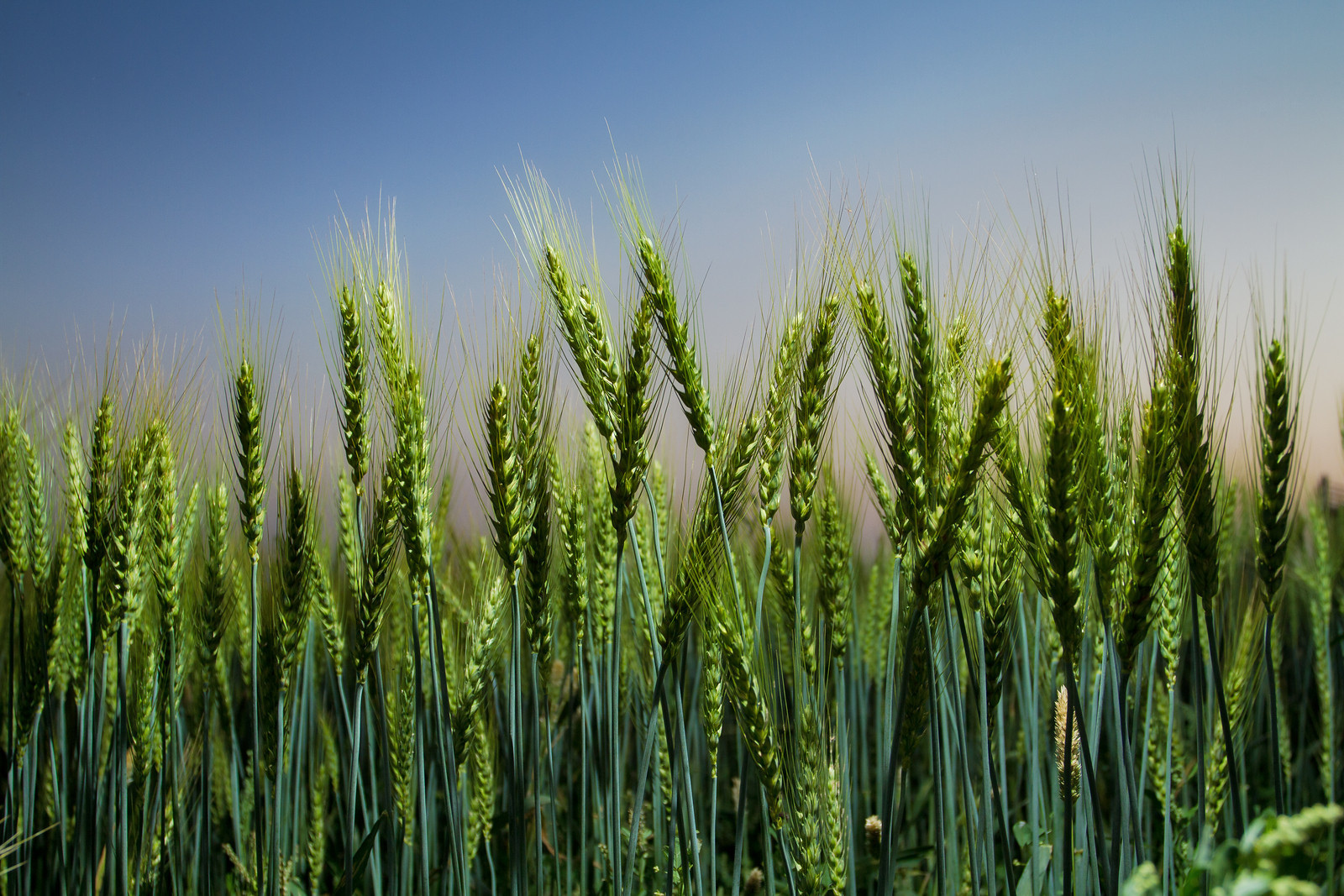
Nutritious vitamin A orange maize boosts health and livelihoods in Zimbabwe
In Zimbabwe, child malnutrition peaked above international thresholds for emergency response. Vitamin A deficiency is the leading cause of preventable blindness in children and can increase risk of measles, diarrhea and respiratory infections. However, biofortification of maize is a sustainable solution to improve health and nutrition in the region.
CIMMYT and Harvest Plus worked together to breed maize with higher amounts of nutritious vitamin A and are working with farmers, seed companies, food processors and millers to make this maize part of the food system in Zimbabwe.
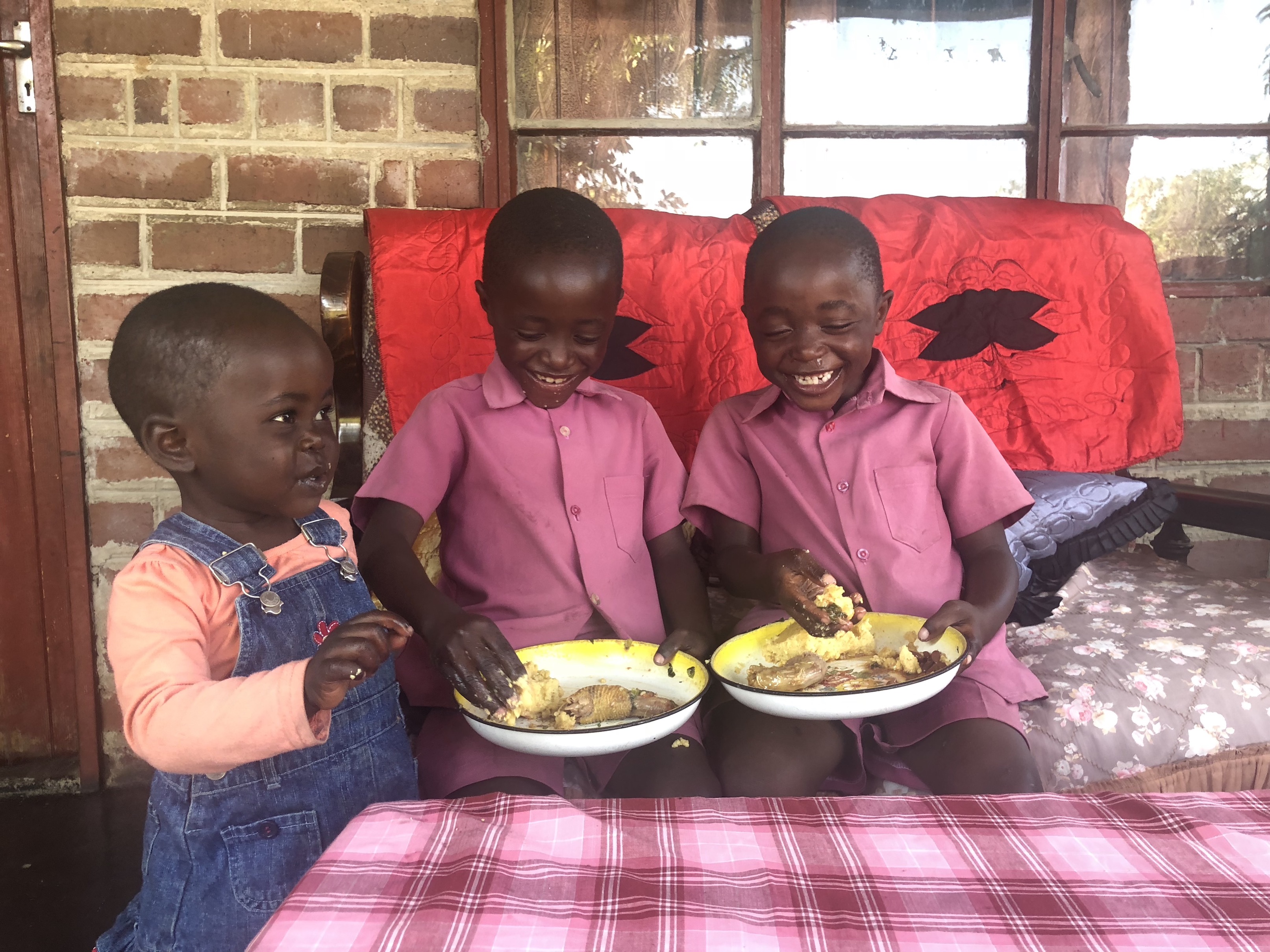
Pakistan wheat seed makeover: More productive, resilient varieties for thousands of farmers
In Pakistan, CIMMYT is working to develop and spread better wheat production systems, by replacing outdated, disease susceptible seeds with new varieties. These new varieties also come with a health benefit — zinc.
According to a 2011 nutrition survey, 39 percent of children in Pakistan and 48 percent of pregnant women suffer from zinc deficiency, leading to child stunting rates of more than 40 percent and high infant mortality. These new seeds will increase the nutrition content of wheat, Pakistan’s number-one food crop, as well as resist diseases such as wheat rust.
Better together: Partnership around zinc maize improves nutrition in Guatemala
Over 46 percent of children under five in Guatemala suffer from chronic malnutrition. More than 40 percent of the country’s rural population is deficient in zinc, an essential micronutrient that plays a crucial role in pre-natal and post-natal development and is key to maintaining a healthy immune system.
CIMMYT, HarvestPlus and Semilla Nueva are working together to change this, through the development and deployment of the world’s first biofortified zinc-enriched maize. Called Fortaleza 3 by Semilla Nueva, it fights against hidden hunger, containing 6-12ppm more zinc and 2.5 times more quality protein compared to conventional maize varieties.
“With the extra income I’ve gotten since switching to F3, I’ve been paying for my daughter to go to school. Fortaleza F3 not only gave me a good harvest, but also the ability to support my daughter’s education,” said Rómulo González, a farmer from the southern coast of Guatemala.
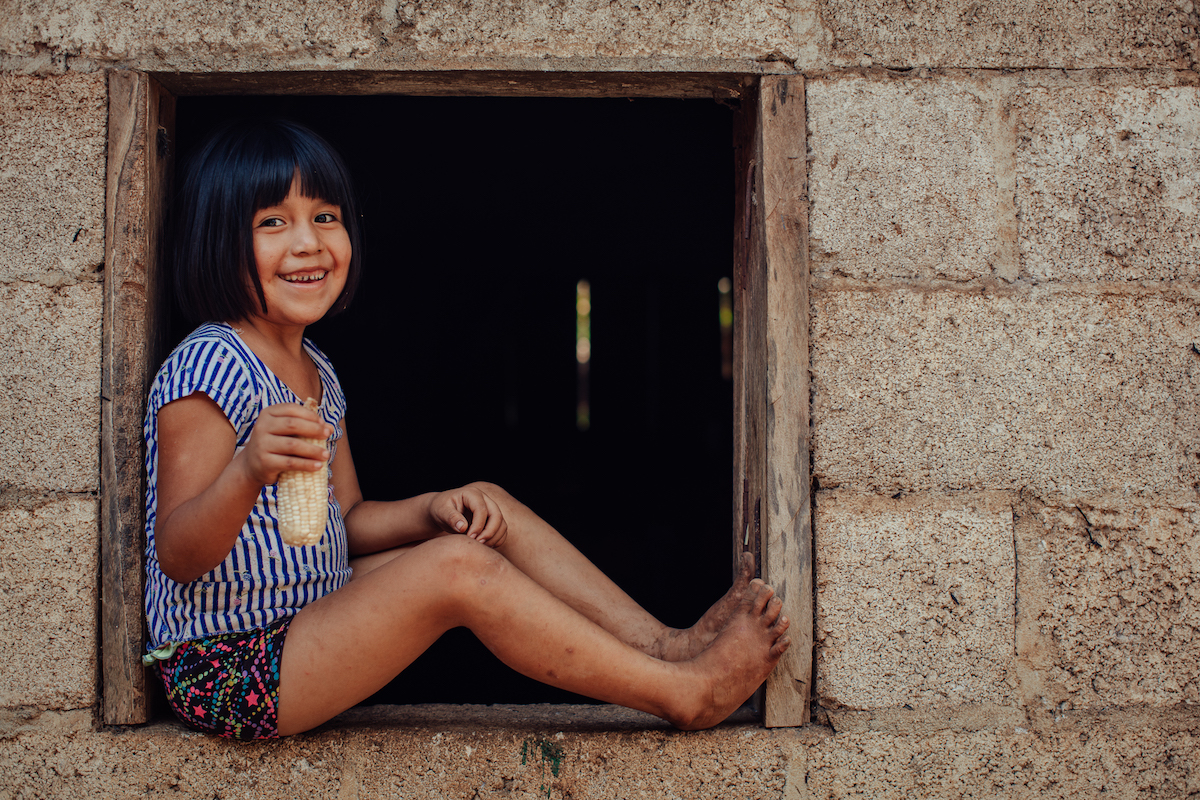
Farmers key to realizing EAT-Lancet report recommendations in Mexico, CIMMYT highlights
The EAT-Lancet Commission Report aims to answer the question: can we feed a future population of 10 billion people a healthy diet within planetary boundaries? It proposes a “planetary health diet” that balances nutrition with sustainable food production.
CIMMYT participated in the report launch in Mexico. “If anybody is able to manage the complex systems that will sustainably yield the volume of nutritious food that the world needs, that’s the farmer,” said Bram Govaerts, Director of Innovative Business Strategies at CIMMYT. “In Mexico, more than 500 thousand farmers already innovate every day and grow maize, wheat and related crops under sustainable intensification practices that CIMMYT and Mexico’s Agriculture Department promote with MasAgro”.
These innovations he mentioned create healthier families and a healthier planet.
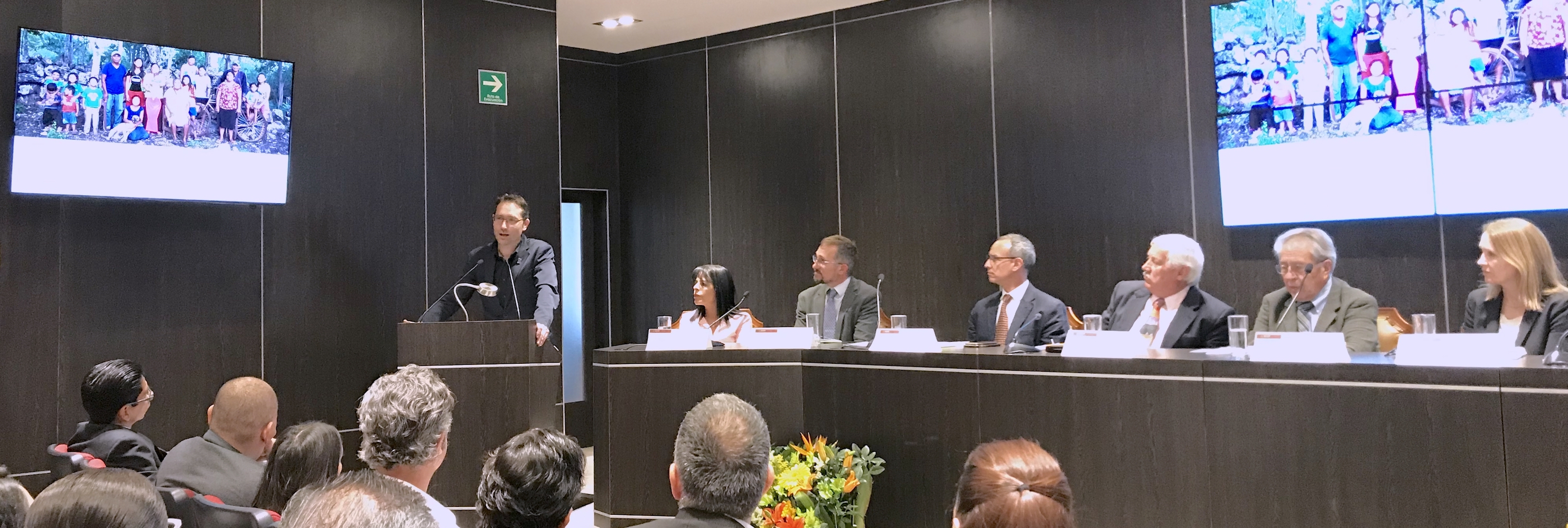
How the data revolution could help design better agronomic investments
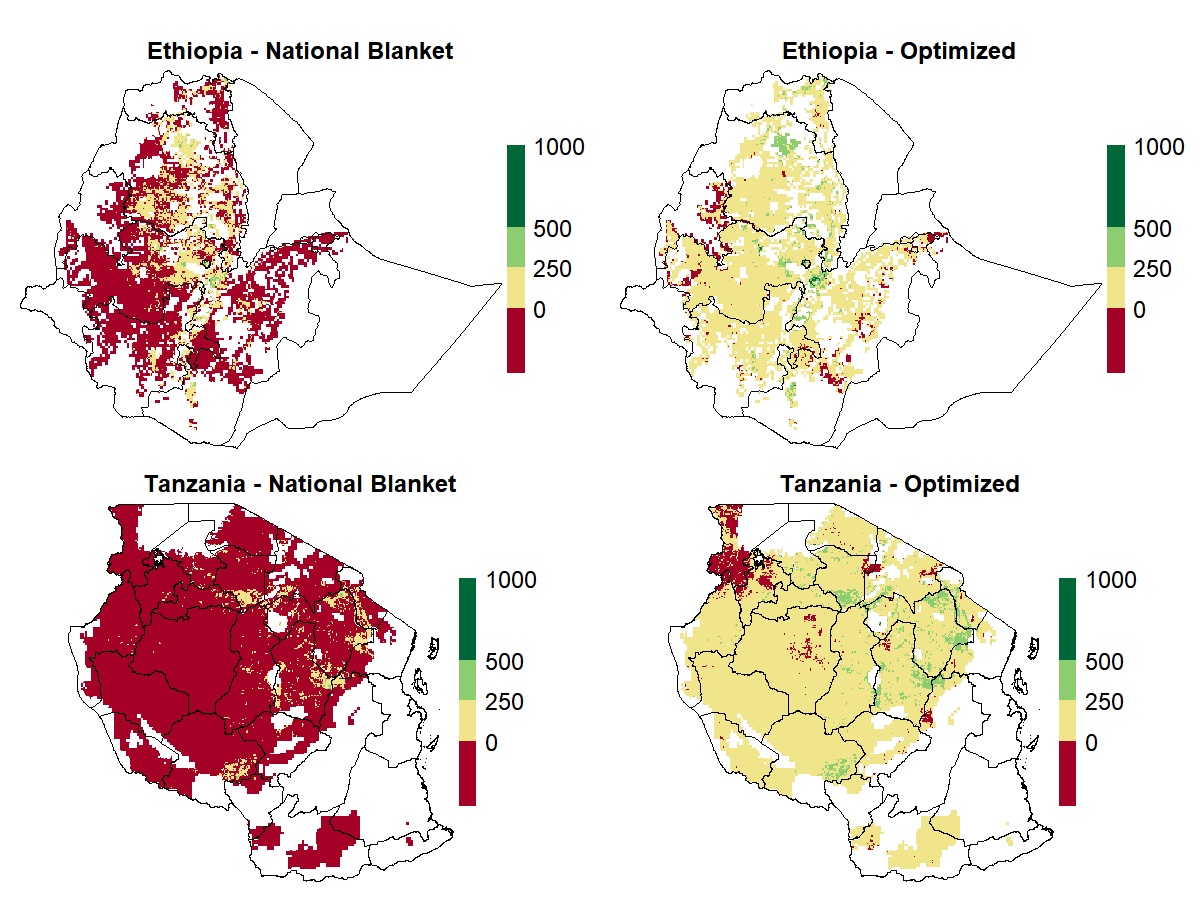
What fertilizer application will give me the best returns? What maize crop variety should I use?
Each farmer faces constraints related to weather uncertainty, soil fertility management challenges, or access to finance and markets. To improve their yields and incomes, African smallholder farmers need agronomic advice adapted to their specific circumstances. The challenge is even greater in sub-Saharan Africa, where agricultural production landscapes are highly diverse. Yet traditional agronomic research was not designed to fit with complex agroecological regions and farming systems. Compounding the problem, research organizations often have limited resources to develop the necessary experiments to generate farm- and site-specific agronomic advice at scale.
“Agronomic research is traditionally not equipped to consider spatial or socio-economic diversity among the millions of farmers it targets,” said Sebastian Palmas, data scientist at the International Maize and Wheat Improvement Center (CIMMYT) in Nairobi, Kenya.
Palmas presented some of the learnings of the Taking Maize Agronomy to Scale in Africa (TAMASA) project during a science seminar called “A spatial ex ante framework for guiding agronomic investments in sub-Saharan Africa” on March, 4, 2019.
The project, funded by the Bill & Melinda Gates Foundation, has used data to improve the way agronomic research for development is done. Researchers working on the TAMASA project addressed this challenge by using available geospatial information and other big data resources, along with new data science tools such as machine learning and Microsoft’s AI for Earth. They were able to produce and package information that can help farmers, research institutions and governments take better decisions on what agronomic practices and investments will give them the best returns.
By adapting the Quantitative Evaluation of the Fertility of Tropical Soils (QUEFTS) model to the conditions of small farmers in TAMASA target countries (Ethiopia, Nigeria and Tanzania), using different layers of information, CIMMYT and its partners have developed a versatile geospatial tool for evaluating crop yield responses to fertilizer applications in different areas of a given country. Because calculations integrate spatial variation of fertilizer and grain prices, the tool evaluates the profitability — a key factor influencing farmers’ fertilizer usage — for each location. The project team can generate maps that show, for instance, the estimated agronomic and economic returns to different fertilizer application scenarios.
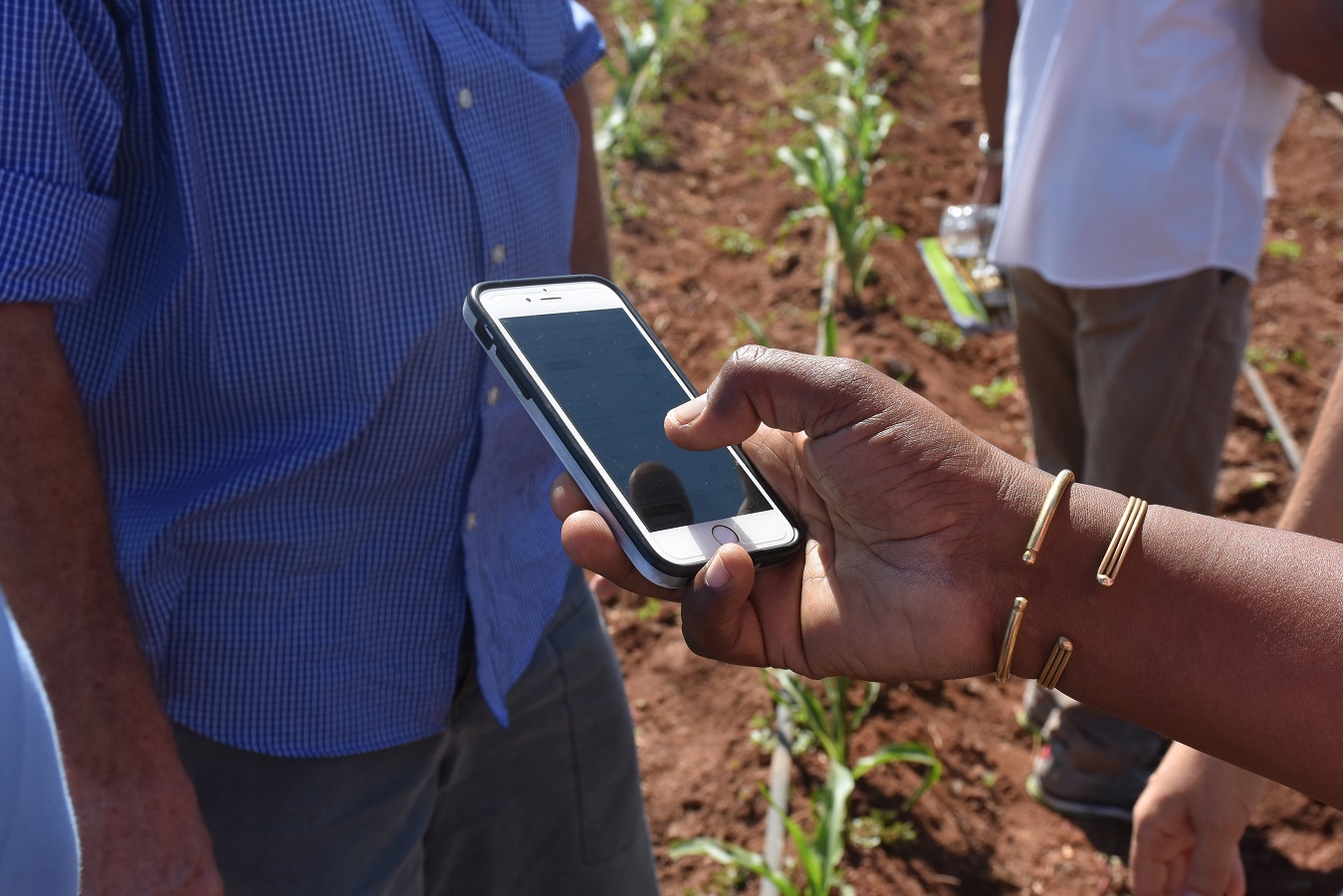
Making profits grow
These tools could potentially help national fertilizer subsidy programs be more targeted and impactful, like the ambitious Ethiopia’s Fertilizer Blending initiative which distributes up to 250,000 tons of fertilizer annually. Initial calculations showed that, by optimizing diammonium phosphate (DAP) and urea application, the profitability per hectare could improve by 14 percent on average, compared to the current fertilizer recommendations.
Such an approach could generate farm-specific advice at scale and boost farmers’ incomes. It could also provide insights on many different issues, like estimating market demand for a new fertilizer blend, or the estimated quantity of additional fertilizer required to bring about a targeted maize yield increase.
Future extensions of the framework may incorporate varietal differences in nutrient management responses, and thus enable seed companies to use the framework to predict where a new maize hybrid would perform best. Similarly, crop breeders could adapt this ex ante assessment tool to weigh the pros and cons of a specific trait and the potential impact for farmers.
The TAMASA team plans to publish the code and user-friendly interface of this new geospatial assessment tool later this year.
Candidate for FAO leadership Qu Dongyu visits CIMMYT’s headquarters to sign MoU and strengthen collaboration
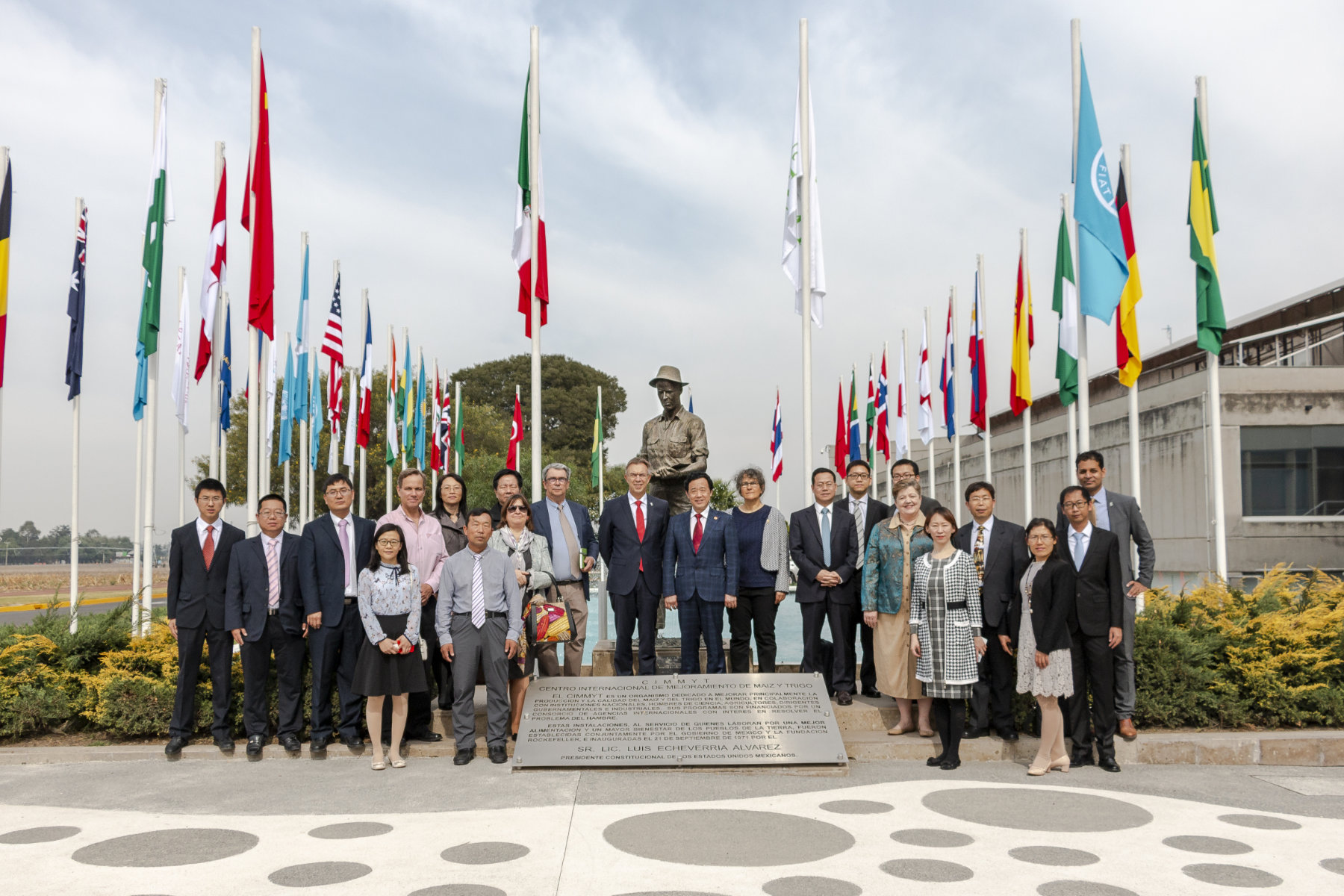
Qu Dongyu, China’s Vice Minister of Agriculture and Rural Affairs, and candidate for the position of Director-General of the Food and Agriculture Organization of the United Nations (FAO), visited the global headquarters of the International Maize and Wheat Improvement Center (CIMMYT) in Mexico on March 16, 2019. He had already visited CIMMYT in 2006.
Vice minister Qu was greeted by students and CIMMYT scientists from China, the director general, the deputy director general and members of the management team. Qu and his delegation learned about CIMMYT’s latest initiatives and toured the campus.
CIMMYT’s director general Martin Kropff explained the organization’s strategic focus on agri-food systems: “Our mandate is on maize and wheat but we think broadly. Our researchers use a systems approach and work on using these two crops to improve peoples’ livelihoods, which is our ultimate goal.”
Qu expressed his career-long efforts for integrating multi-disciplinary approaches to tackle global challenges and said that he was “happy to see CIMMYT combining breeding — for which CIMMYT is famous — with value-added approaches to bring together science, farmers and industry.”
With innovation and the end user playing key roles in the vice minister’s agenda, Qu enjoyed learning about the Excellence in Breeding Platform’s target product profiles work and two-way communication channels from innovation hubs in Mexico.
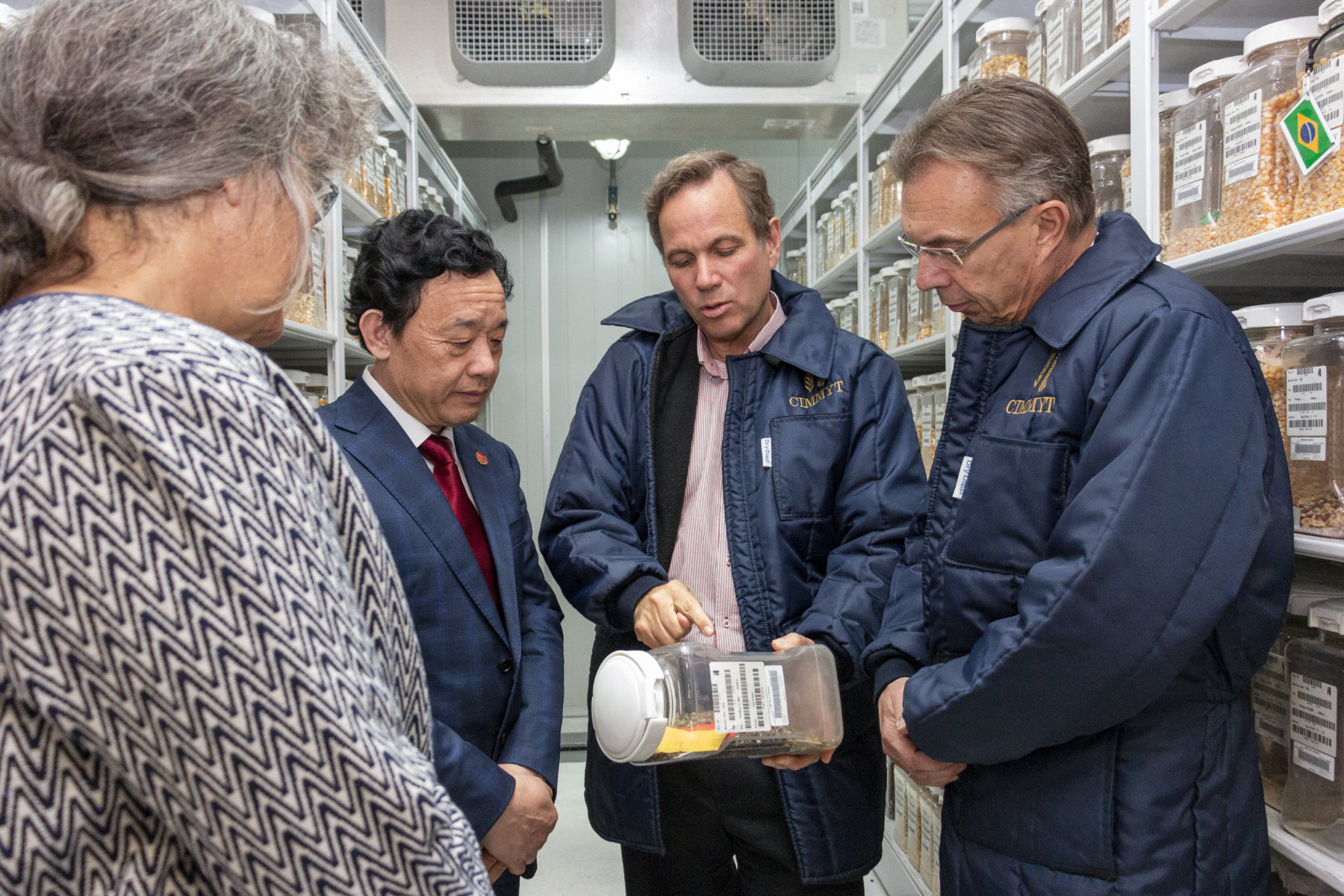
During the visit, Qu was also introduced to CIMMYT’s small-scale machinery, which is used around the world to sustainably intensify production. CIMMYT often sources machines, such as seed planters and harvesters, from China to provide effective and efficient solutions that add tangible value for smallholders at an appropriate price point.
Bringing together advanced technology and inexpensive tools, CIMMYT pioneered the GreenSeeker, a handheld tool to advise farmers on the appropriate amount of nitrogen fertilizer to add to their crops. This tool gives farmers the double benefit of increased profitability and reduced negative environmental impacts. The director of CIMMYT’s Sustainable Intensification program, Bruno Gérard, showed a machine-mountable version of this tool, which could connect to a two-wheel tractor and automatically add the appropriate amount of fertilizer.
Gérard also explained CIMMYT’s efforts to develop mechanization as a service, pointing to the manual on developing mechanization service providers, jointly developed by CIMMYT and FAO: “Mechanization has the potential to improve environmental sustainability, farm productivity and reduce labor drudgery. If mechanization is to be adopted at scale and sustainably, in most cases it has to be provided through service provision to smallholder farmers.”
At the end of the visit, to underline the shared commitment to collaboration that began in the 1970s, Kropff and Qu signed a memorandum of understanding for the establishment of a China-CIMMYT joint laboratory for maize and wheat improvement.
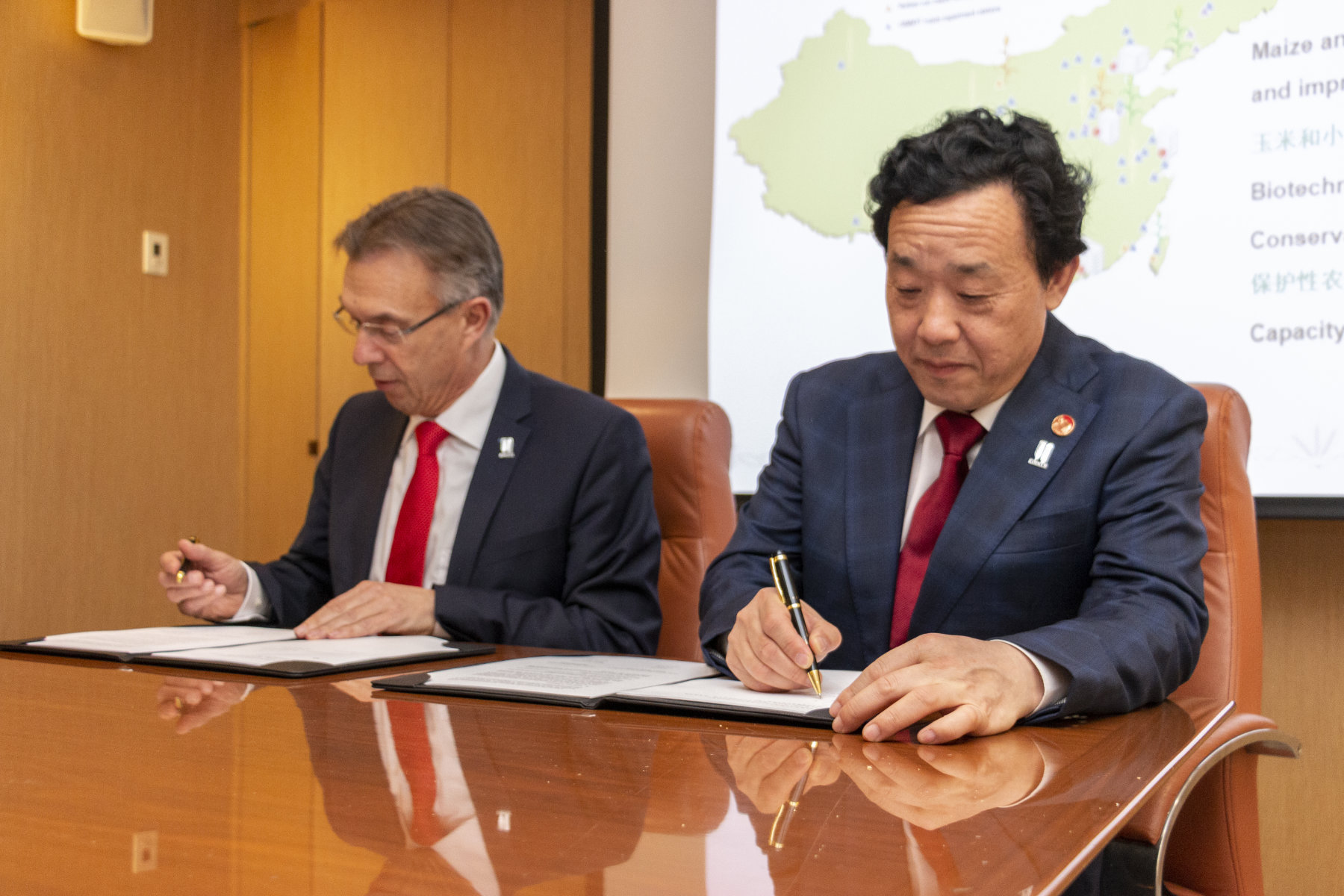
Ethiopia calls for continued collaboration to increase wheat production and meet nutritional and food security
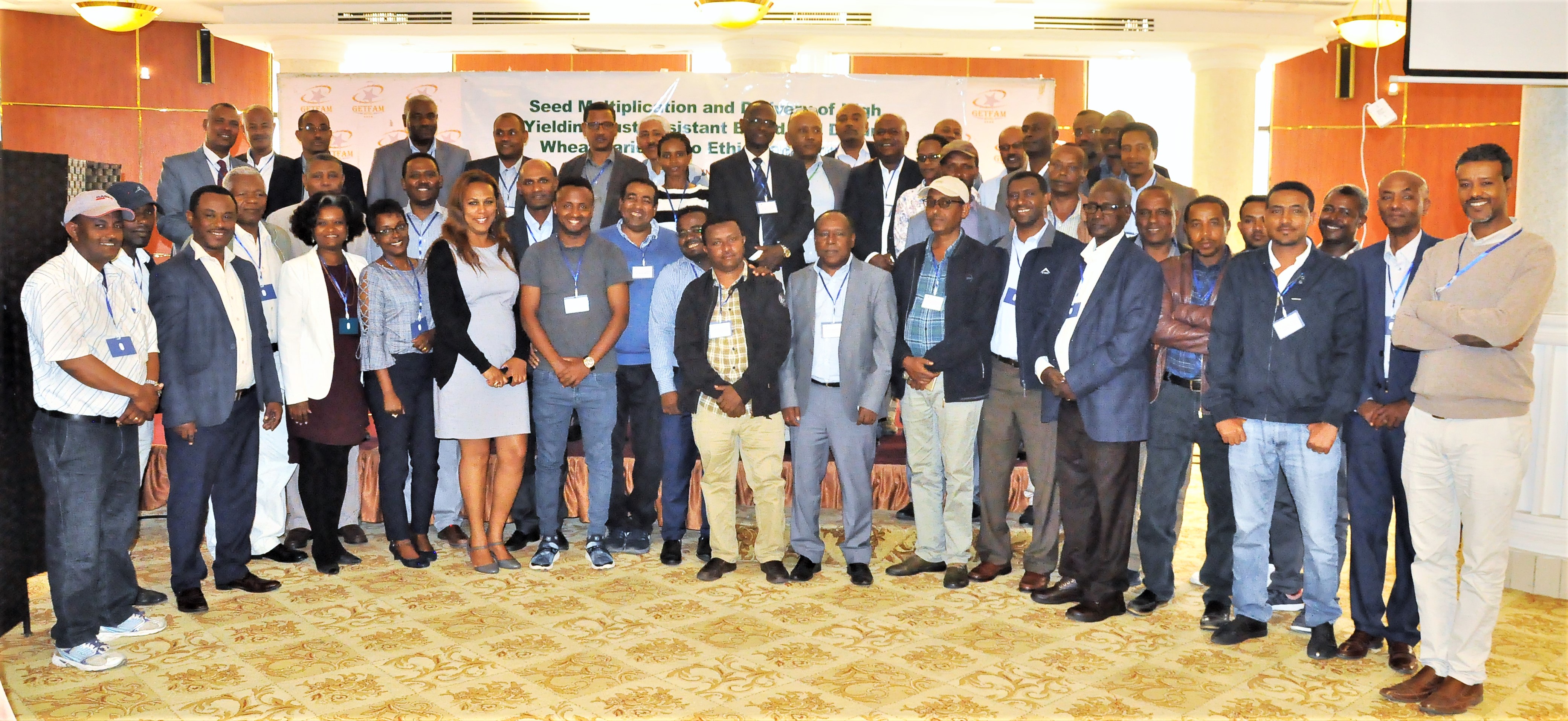
The Ethiopian wheat sector has seen progress since the early 2000s, more than doubling the average farm yields from 1.13 tons per hectare in 1998/99 to 2.74 tons per hectare in 2017/18. Progressive farmers who plant improved wheat varieties and follow recommended agronomic practices could harvest four to six tons per hectare in high-potential wheat growing areas. However, the production is not keeping up with the growing wheat demand: imports reached over 1.5 million tons last year. The Ethiopian government has announced recently that the country should become wheat self-sufficient over the next four years.
One of the biggest wheat production challenges in Ethiopia has been the stem rust and yellow rust diseases caused by Pucccinia spp, which severely affected popular wheat varieties like Kubsa, Galema and Digalu that wiped out from production.
In response to these losses, the International Maize and Wheat Improvement Center (CIMMYT) started an emergency project to multiply and disseminate rust-resistant wheat varieties in the affected regions in 2014, with support from USAID.
The following year, CIMMYT launched the Seed Multiplication and Delivery of High Yielding Rust Resistant Bread and Durum Wheat Varieties to Ethiopian Farmers project. It benefitted people in 54 woredas (districts) of 4 regions: Amhara, Oromia, SNNP and Tigray. CIMMYT collaborated with the Ethiopian Institute of Agricultural Research (EIAR), regional agricultural research institutes and the regional bureaus of agriculture.
This wheat seed scaling project wrapped up with a closure workshop on March 7, 2019. Organized by CIMMYT and EIAR, it gathered representatives from USAID, policymakers, researchers and other governmental and non-governmental institutions.
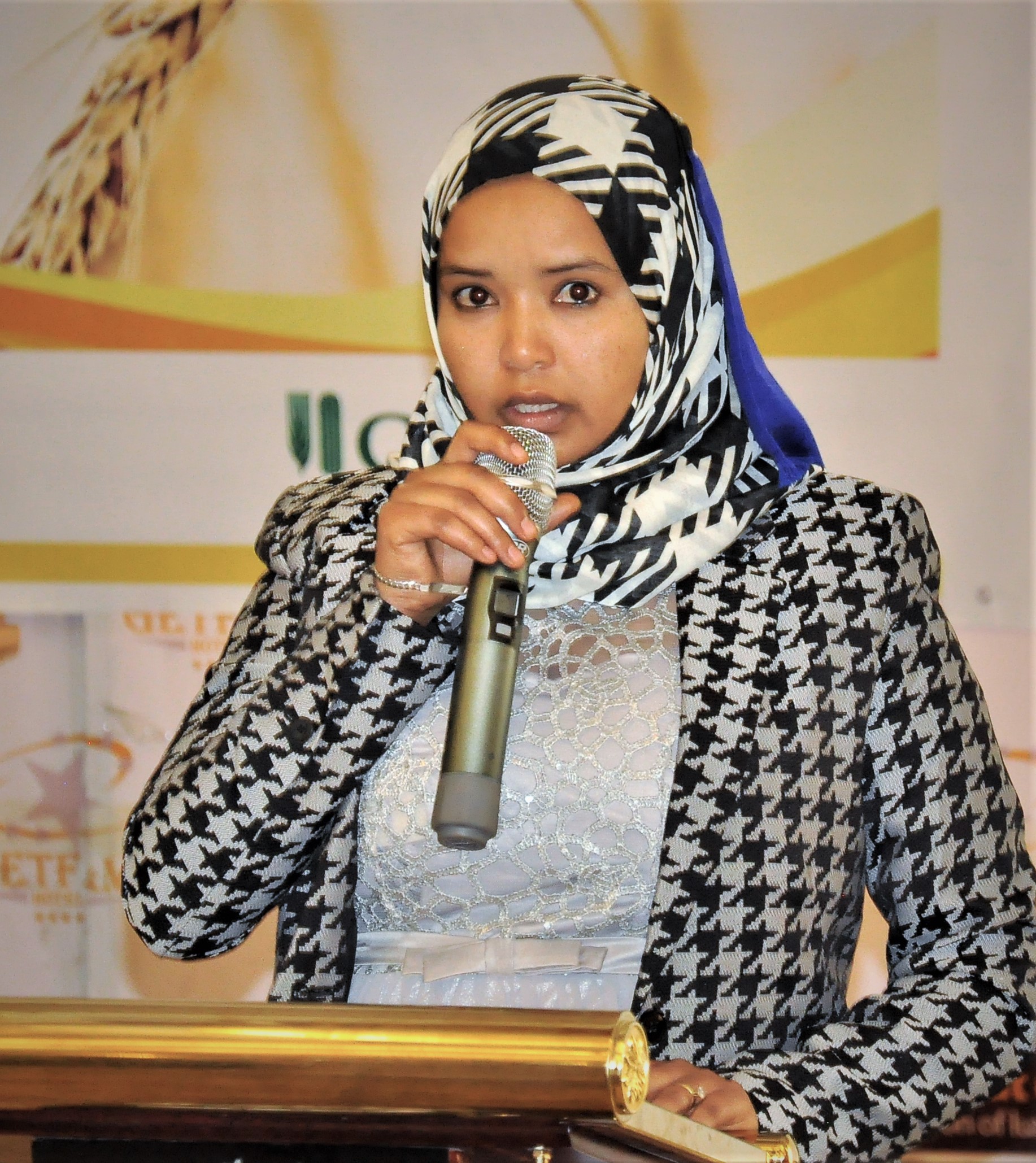
State minister of agriculture Aynalem Nigussie noted that the project boosted farmers’ productivity thanks to better seeds, improved farming practices and increased knowledge to deal with wheat rust diseases. She recognized that the project aligned with national priorities, as the government is devising a new seed policy to address the current challenges of the Ethiopian wheat seed sector.
CIMMYT’s representative in Ethiopia, Bekele Abeyo, highlighted some of the project outcomes. Some of the achievements in the past four years included the release and demonstration of 23 wheat varieties — 18 bread and 5 durum types —, increased access to these improved seeds for 131,132 households and production of 39,750 tons of wheat grain. Extension agents from 54 woredas participated in training in wheat rust management, recommended agronomic packages for the new wheat varieties, and field data collection and management.
Lessons learned
Abeyo explained that the project could reach a high number of farmers thanks to effective teamwork between the various stakeholders, seed support on revolving bases and a decentralized seed production to reach even remote places. Clustering farmers’ plots favored quality seed production.
Participants flagged weak market linkages, particularly for farmers producing durum wheat, , as a bottleneck to address. Workshop participants recommended the establishment of a wheat task force involving the private sector and with continuous support from funders like USAID.
The director general of EIAR, Mandefro Nigusse, said that the issues raised are inputs for further actions, and some will have to be directed to researchers and breeders to come up with additional solutions for the challenges the wheat sector is facing.
Eyasu Abrha, Advisor to the Minister of Agriculture, officially closed the workshop. He noted that the government of Ethiopia is putting effort into ensuring nutritional and food security, and that projects such as this one are important to address critical challenges in the sector. Abrha acknowledged the support of CIMMYT, EIAR and USAID, and called for a continued collaboration with the government of Ethiopia to meet nutritional and food security goals.


